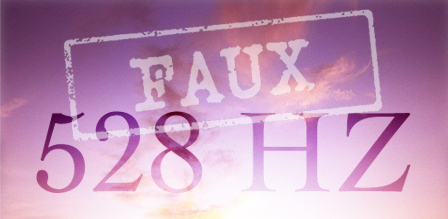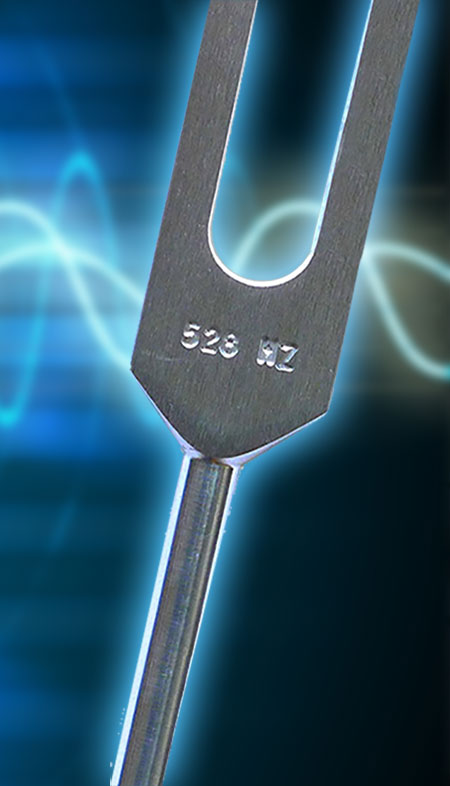Is 528 Hz frequency a myth?

Is 528 Hz frequency a myth?
By Emmanuel Comte
His offering was one silver charger, the weight thereof was an hundred and thirty shekels one silver bowl of seventy shekels, after the shekel of the sanctuary; both of them were full of fine flour mingled with oil for a meat offering;
Numbers, 7
Copyright 2016 Medson center
Summary
The 528 Hz tuning fork is another issue that deserves some refreshing insights.
The understanding of frequencies, sounds and vibrations therapies is a subject that inspires us for many years. This article is in addition to the one written about the 432 Hz tuning fork.
The purpose of what I undertake on the following lines is to raise the awareness in the use of sounds and frequencies and to contribute in their right integration.
Here are some clarifications in relation to another fork in fashion: the 528 Hz and the tuning fork called Solfeggio.
Here are all the Solfeggio tuning forks that the MedSon center keeps in an archive in its junk box.
I learned about these forks a few years ago from my students - that I thank here - and I had to give it an interest. What I discovered, after some research, is a discourse that seems eccentric, resembling very much the words of those seeking to justify the use of the tuning fork we previously mentioned, at 432 Hz. Their speech has no scientific basis, to such an extent that it also seemed useful to clarify the issue.
What is it about?
Some authors, largely quoted on the web, evoke in their writings the use of frequencies of a so-called ancient sol-fa, which exists only in their imagination. In light of what has been previously stated about the A at 432 Hz, please note that no serious musicological study can support the theories that we will discuss here briefly.
The 528 Hz pitch, as described by their instigators looks like a sham.
The first reason is that for us, the word sol-fa, in the modern sense, is a word representing a field taught in music academies which has alienated many people from the original meaning of the music. Recall that in the French and Canadian music academies, the child who wants to learn music must first undergo mandatory music lessons for a minimum of one school year without touching any musical instrument.
The term "sol-fa study" is synonymous with tedious classes repelling forever many children who could otherwise for that matter be great musicians; as would, for example, teaching a language by limiting its initiation to the learning of grammar rules. So for us, the name given to the so-called Solfeggio therapeutic tuning forks is to be taken lightly. It is therefore inappropriate for us and offers nothing really original.
If one is interested in the etymological meaning of the word sol-fa, it includes the names of the notes Sol and Fa, and as a verb "to sol-fa" indicates a way to sing by naming the notes. The sol-fa preceded another newer system named solmization; a method to learn signing.
The second reason - and I think I was clear about this in the previous article on the A at 432 Hz - is that there is no fixed reference in assigning the frequency of a note, except in very recent times and therefore clearly not in the Middle Ages. S
aying otherwise is pure invention that is not based on historical data. A fixed reference was decided only in 1859 for the A at 435 Hz, therefore 150 years ago; and about half-century ago, in 1953 for the current tuning fork (ISO 440 Hz standard).
The Latin language in signing is certainly a vibratory language but we have serious reservations about the semantic content of Gregorian chants, whose words from Catholicism are sometimes very distantly related to the original message of Christ.
We rather believe that the true Gregorian chant is not necessarily the one developed by the Catholic Church, which has eradicated many of the original components.
The creators of the myth about the 528 Hz frequency say baseless facts, based on so-called biblical verses from the Book of Numbers, 7, 12-83, which are supposedly reproducing the "Pythagorean frequencies", 174 - 285-396-417-528-639-741 and 852 Hz, which would do even more by "repairing our DNA", no less.
Such feats are brought up without the support of any scientific evidence or clinical study permitting such assertions.
I reproduce below an extract from the biblical reference at the origin of this story.
It is some kind of a grocery list, formed by a long list of measures and numbers of items for sacrifices to the gods:
(...)
12. And he that offered his offering the first day was Nahshon the son of Amminadab, of the tribe of Judah;
13. And his offering was one silver charger, the weight thereof was an hundred and thirty shekels, one silver bowl of seventy shekels, after the shekel of the sanctuary; both of them were full of fine flour mingled with oil for a meat offering;
14. One spoon of ten shekels of gold, full of incense;
15. One young bullock, one ram, one lamb of the first year, for a burnt offering;
16. One kid of the goats for a sin offering;
17. And for a sacrifice of peace offerings, two oxen, five rams, five he goats, five lambs of the first year: this was the offering of Nahshon the son of Amminadab.
18. On the second day Nethaneel the son of Zuar, prince of Issachar, did offer.
19. He offered for his offering one silver charger, the weight whereof was an hundred and thirty shekels, one silver bowl of seventy shekels, after the shekel of the sanctuary; both of them full of fine flour mingled with oil for a meat offering;
20. One spoon of gold of ten shekels, full of incense;
21. One young bullock, one ram, one lamb of the first year, for a burnt offering;
22. One kid of the goats for a sin offering;
23. And for a sacrifice of peace offerings, two oxen, five rams, five he goats, five lambs of the first year: this was the offering of Nethaneel the son of Zuar.
24. On the third day, (...)
Images of ancient sacrifices. Here as decoration of an ancient Greek vase.
Roman sacrifice romain similar to that described in Numbers, 7.
78. On the twelfth day Ahira the son of Enan, prince of the children of Naphtali;
79. His offering was one silver charger, the weight whereof was an hundred and thirty shekels, one silver bowl of seventy shekels, after the shekel of the sanctuary; both of them full of fine flour mingled with oil for a meat offering;
80. One golden spoon of ten shekels, full of incense;
81. One young bullock, one ram, one lamb of the first year, for a burnt offering;
82. One kid of the goats for a sin offering;
83. And for a sacrifice of peace offerings, two oxen, five rams, five he goats, five lambs of the first year: this was the offering of Ahira the son of Enan.
Guido d'Arezzo, "inventor" of the notes, according to Catholic tradition.
Joseph Puelo and Len Horowitz
Len Horowitz and Joseph Puelo behind this preposterous story, wrote that this text was deciphered using the ancient Pythagorean method of reducing the Bible verses in simple numbers.
Incidentally, reducing a text to numbers is not a Pythagorean method. This is called numerology. Taking any random text, a phone book for example, could feed the possibility to draw numbers and build a system of frequency and to build an equally bizarre story as the one we describe here; not forgetting to add the ingredients of mystery and sprinkle a few pinches of magic.
Then, these authors argue that these codes revealed a series of six electromagnetic frequencies, corresponding to six missing notes of the old grading scale called solfeggio frequencies.
Not missing any notes
Solfeggio frequencies is a term coined by Leonard Horowitz and Joseph Puleo in 1999. It relates to a musical scale referring to the belief that a set of six frequencies, from numerology, have been used for centuries in Gregorian and Sanskrit chants. One wonders what the Sanskrit has to do here in the middle.
The Tuning Fork, illusstrating a paper by Jacques Chailley.
That seems very strange, because there was no reference frequency in antiquity or in the Middle Ages; at most, low, midrange and treble, based on human vocal.
Then they make a fuss of the famous hymn to St-Jean-Baptiste (see illustration above) presented as a hidden and mysterious song, while the song is neither hidden nor mysterious.
Instead, it is well known and not mysterious at all. Just open any encyclopedia on the article "musical notes", to be convinced yourself. Furthermore they argue that the given frequencies are those of the hymn, which is a historical implausibility.
These frequencies cannot therefore have been lost because they did not exist, in the sense that we would hear nowadays.
The frequencies in question here cannot be based on any musicological data. No specific height was set in the Middle Ages or earlier, except in China, in very limited conditions.
Moreover, the intervals given in this system are false and are not following the Pythagorean logic to which these authors dare to refer.
Recall that, according to the renowned musicologist Jacques Chailley, the ancient Greeks did not tune forked heights and the formal standardization of notes in Europe dates only from 1859.
Ut Queant Laxis, the St-John Hymn : the first syllabes of each phrase gave the notes of the Gui d'Arezzo scale.
The Greeks only say "tones" or what is regarding "string tension"; the speculations about these tones apply only to the division of the intervals between the strings of the lyre and they comment theoretical diagrams. Everything that relates to the note heights is calculated on the Pythagorean monochord, that is to say an instrument of extreme precision for the interval measures, but no less extreme vagueness in respect to the original accord, which is never mentioned.
Jacques Chailley
If 528 Hz is an E, the other frequencies listed do not meet any Pythagorean or Zarlinian ratio.
If 528 Hz is the C (which would be more logical, given the height of the note), we obtain a A at 440 Hz in the Zarlinian system (ratio 5/3); a frequency these fanciful authors are supposed to fight, because according to them it would set the mind out of tune being the result of a global conspiracy orchestrated by the Illuminati (no less).
We have once again been clear about the A at 440 Hz and explained that this frequency was used since the Baroque era in Europe, therefore long before the 20th Century when it became an international standard.
Finally, these authors state that the 528 Hz frequency is well known to biologists and additionally effective to repair DNA.
We have seen nothing posted anywhere on that matter.
The authors in question also wrote that 528 Hz is the frequency of love.
Why not, you may say? Limiting the vibration of love to the note of a tuning fork tuned to the frequency of 528 Hz seems very reductionist in our opinion.
The frequency of love and all its harmonics is well beyond the issue of a note tuned to this tuning fork.
So all these theories seem baseless fabrications created out of fantasy and mystification.
The Solfeggio story sounded like a farce and a hoax and it seemed important to us to denounce it.
And even if talking about it exacerbates the problem, this article will fortunately help you to avoid present or future hoaxes, thanks to the scientific process we constantly seek to develop in everything; which helps us to free ourselves from memories of misty mystifications that kept us for too long in outdated concepts.
We need light to better understand and integrate sounds and frequencies, and the team at Centre MedSon hope these lines allow our readers to see more clearly.
The 528 Hz tuning fork.
© 2014 Emmanuel COMTE medson.net
To sing with your own Pitch: intuitive chant
Flash Mob Le Thoronet Harmonic Choir Emmanuel Comte (2014)
Sonologie 2014 Spontaneous song, intuitive song. Pythagorean choir, conducted by Emmanuel Comte MedSon Center with the participation of Claude Brame. Flash Mob of June 26, 2014 at Thoronet Abbey, France.
References
¤ Jacques Chailley, Le diapason ancien (Ancient tuning), in Musica Nr17, 1955 August, p.38.
¤ The Bible, Numbers, 7, 12-83.
Additional Notes
¤ Pythagorean Scale ratios are :
1 - 9/8 - 81/64 - 4/3 - 3/2 - 27/16 - 243/128 - 2
¤ Gioseffo Zarlino (1517-1590) is an italian composer witch searched to improve Pythagorean Scale because pythagorean thirds are wrong. Hi Scale is called Natural Scale or Just Intonation Scale, with following ratios:
1 - 9/8 - 5/4 - 4/3 - 3/2 - 5/3 - 15/8 - 2.









